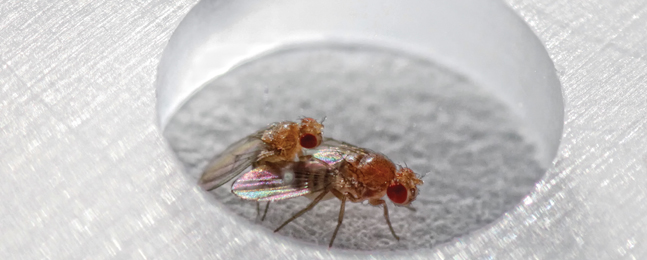Fruit Fly Fandango

Photo by Mike Lovett
by Nathan Donelson
Who could have imagined the ’70s hit “Get Down Tonight,” by KC and the Sunshine Band, would so aptly apply to the tiny, social world of fruit fly courtship?
My colleagues and I recently reported in the science journal PLoS ONE that fruit fly hookups depend on the ability of potential couples to “do a little dance, make a little love,” just as KC and his band crooned.
Successful courtship starts with the right venue. Drosophila melanogasters’ favorite singles bar can be found atop a piece of rotting fruit — their own version of a dance club. As the prospects mingle, important information is exchanged. Male fruit flies, not unlike their human counterparts, call out to the ladies milling about nearby. These attention-seeking messages consist of two persistent — and quite direct — “shouts” that fruit flies create with their wings: “Hey!” (a purring sound known as the pulse song) and “How you doin’?” (a humming sound called the sine song). Meanwhile, females send out their own come-hither cues in the form of a chemical signal, or perfume-like pheromone, to the courting males, announcing their interest in sexual overtures.
When a female slows her pace in response to calls from the dance floor, the male moves in closer, dropping the “Hey!” portion of the call in favor of the more intimate “How you doin’?” signal. If she is still receptive, the male dances his way ever closer, tapping her butt with his front legs, sniffing it with his antennae and tasting it with his proboscis and forelegs. This is his way of evaluating her suitability as the object of his amorous intentions. If everything goes well, eventually a one-night stand ensues.
Not surprisingly, when a miscommunication occurs, males have a much more difficult time winning a mate. Timing is everything, as is distance. If the male is too close or too far, or his shouts are out of sync, he will most likely get the cold shoulder. For her part, by lingering at a certain distance from the male — within smelling distance — the female can encourage his advances. In this social environment, we discovered that scoring depends not only on saying the right things, but also on the fly’s ability to read the signals of others at the right time.
Males who lack an ability to smell due to an olfactory mutation have a difficult time switching to the dominant “How you doin’?” signal at close range. Without a functioning olfactory feedback mechanism, the male is unable to tell that he is close to a female who is interested, and he can’t move the relationship to the next level.
From the perspective of the female, it’s like trying to have a one-on-one conversation with a suitor who is still trying to pick up every other available date in the room. Even though the male is handsome, strong, maybe even free of parasites, interest from the female quickly wanes when he keeps giving the wrong signal. All the parts of the song are there; he just can’t read the cues and adjust to the progression of the relationship. In a kind of strange homage to Cyrano de Bergerac, the male fruit fly that uses his nose as he speaks sweet nothings is best able to woo the female.
So next time you’re out busting a move on the dance floor, think of the noble fruit fly passionately conducting his own miniature fandango. Remember, what is said is just as important as the moves. And being able to read feedback is crucial to success.
Even across 500 million years of evolution, the drive to get the girl keeps flies and humans singing the same tune.
Nathan Donelson is a postdoctoral fellow in biology professor Leslie Griffith’s lab.
